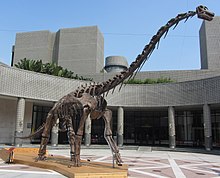
Sauropoda, whose members are known as sauropods, is a clade of saurischian ('lizard-hipped') dinosaurs. Sauropods had very long necks, long tails, small heads, and four thick, pillar-like legs. They are notable for the enormous sizes attained by some species, and the group includes the largest animals to have ever lived on land. Well-known genera include Brachiosaurus, Diplodocus, Apatosaurus and Brontosaurus.
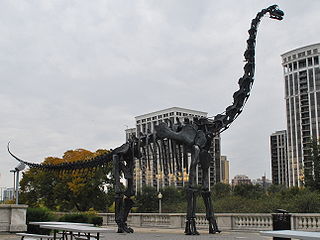
The Brachiosauridae are a family or clade of herbivorous, quadrupedal sauropod dinosaurs. Brachiosaurids had long necks that enabled them to access the leaves of tall trees that other sauropods would have been unable to reach. In addition, they possessed thick spoon-shaped teeth which helped them to consume tough plants more efficiently than other sauropods. They have also been characterized by a few unique traits or synapomorphies; dorsal vertebrae with 'rod-like' transverse processes and an ischium with an abbreviated pubic peduncle.
Eucamerotus was a genus of sauropod dinosaur from the Barremian-age Lower Cretaceous Wessex Formation (Wealden) of the Isle of Wight, England.
Borealosaurus is a genus of titanosaurian sauropod dinosaur from the Late Cretaceous of northern China. The type species is Borealosaurus wimani, which was named in 2004.

Sonorasaurus is a genus of brachiosaurid dinosaur from the Early to Late Cretaceous. It was a herbivorous sauropod whose fossils have been found in southern Arizona in the United States. Its name, which means "Sonora lizard", comes from the Sonoran Desert where its fossils were first found. The type species is S. thompsoni, described by Ratkevich in 1998.
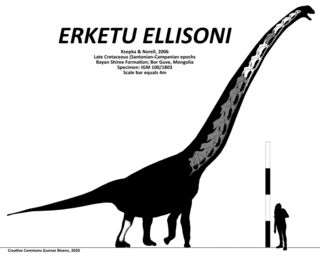
Erketu is a genus of somphospondylan sauropod dinosaur that lived in Asia during the Late Cretaceous roughly between 96 million and 89 million years ago. Its fossils were found in Mongolia between 2002 and 2003 during a field expedition and first described in 2006; later on in 2010 due to some cervicals that were left behind in the expedition. Erketu represent one of the first sauropods described from the Bayan Shireh Formation. The elongated cervical vertebrae of Erketu indicates that it was the sauropod with the longest neck relative to its body size.

Jiangshanosaurus is a genus of herbivorous titanosauriform sauropod dinosaur that lived in China approximately 92-88 million years ago, during the Turonian-Coniacian stage of the Late Cretaceous.

Phuwiangosaurus is a genus of titanosaur dinosaur from the Early Cretaceous (Valanginian-Hauterivian) Sao Khua Formation of Thailand. The type species, P. sirindhornae, was described by Martin, Buffetaut, and Suteethorn in a 1993 press release and was formally named in 1994. The species was named to honor Princess Maha Chakri Sirindhorn of Thailand, who was interested in the geology and palaeontology of Thailand, while the genus was named after the Phu Wiang area, where the fossil was discovered.
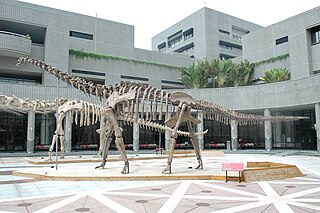
Huanghetitan, is a genus of sauropod dinosaur from the early Cretaceous Period. It was a basal titanosauriform which lived in what is now Gansu, China.
Fusuisaurus is a genus of sauropod dinosaur from the Early Cretaceous of China. Fragmentary postcranial remains of this animal have been discovered in 2001 in the Napai Formation of Guangxi, China and consist of the left ilium, left pubis, anterior caudals, most of the dorsal ribs and distal end of the left femur. This sauropod has been described as a basal titanosauriform.

Xenoposeidon is a genus of rebbachisaurid sauropod dinosaur from the Early Cretaceous of England, living about 140 million years ago. It is known from a single partial vertebra with unusual features, unlike those of other sauropods. This bone was first discovered in the early 1890s but received little attention until it was found by University of Portsmouth student Mike Taylor, who formally described and named it in 2007 with Darren Naish.

Brachiosaurus is a genus of sauropod dinosaur that lived in North America during the Late Jurassic, about 154–150 million years ago. It was first described by American paleontologist Elmer S. Riggs in 1903 from fossils found in the Colorado River valley in western Colorado, United States. Riggs named the dinosaur Brachiosaurus altithorax; the generic name is Greek for "arm lizard", in reference to its proportionately long arms, and the specific name means "deep chest". The most recent estimate suggests that Brachiosaurus would have measured between 22 metres (72 ft) in length and 35 metric tons in body mass, smaller than its relative Giraffatitan. It had a disproportionately long neck, small skull, and large overall size, all of which are typical for sauropods. Atypically, Brachiosaurus had longer forelimbs than hindlimbs, which resulted in a steeply inclined trunk, and a proportionally shorter tail.

Ruyangosaurus is a genus of titanosauriform sauropod dinosaur recovered from the Early Cretaceous Haoling Formation of China. The type species is R. giganteus, described in 2009 by Lü Junchang et al.
Yunmenglong is an extinct genus of somphospondylan sauropod known from the late Early Cretaceous of Henan Province, central China. Its remains were discovered in the Haoling Formation of the Ruyang Basin. The type species is Yunmenglong ruyangensis, described in 2013 by Junchang Lü et al. on the basis of an incomplete postcranial skeleton. Yunmenglong shares some characters with Euhelopus, Qiaowanlong and Erketu, and a phylogenetic analysis places it as a sister taxon of Qiaowanlong, both grouped with Erketu in a position more derived than Euhelopus but basal to Titanosauria.
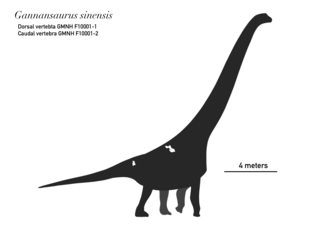
Gannansaurus is an extinct genus of somphospondylan sauropod dinosaur known from the late Late Cretaceous Nanxiong Formation of Ganzhou Basin, Jiangxi Province of southern China. It is known from specimen GMNH F10001 which consists of a single, nearly complete dorsal vertebra and a mid-caudal vertebra. Gannansaurus was first named by Lü Junchang, Yi Laiping, Zhong Hui and Wei Xuefang in 2013 and the type species is Gannansaurus sinensis. Gannansaurus shares some characters with Euhelopus, indicating that it is more closely related to it rather than to other titanosauriforms.

Yongjinglong is an extinct genus of titanosauriform sauropod dinosaur known from the Early Cretaceous of Lanzhou-Minhe Basin of Gansu Province, China. It contains a single species, Yongjinglong datangi.

Padillasaurus is an extinct genus of titanosauriform sauropod known from the Early Cretaceous Paja Formation in Colombia. It contains a single species, Padillasaurus leivaensis, known only from a single partial axial skeleton. Initially described as a brachiosaurid, it was considered to be the first South American brachiosaurid ever discovered and named. Before its discovery, the only known brachiosaurid material on the continent was very fragmentary and from the Jurassic period. However, a more recent study finds it to be a basal somphospondylan.

Sibirotitan is a genus of somphospondyl sauropod from the Ilek Formation of Russia. The type and only species is S. astrosacralis.
